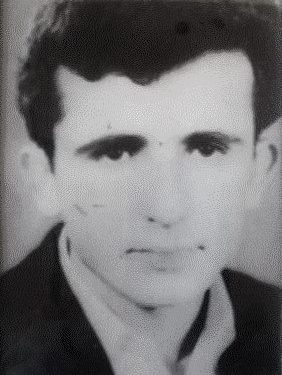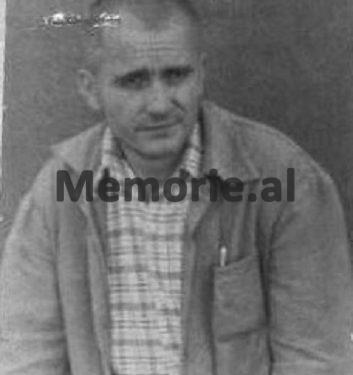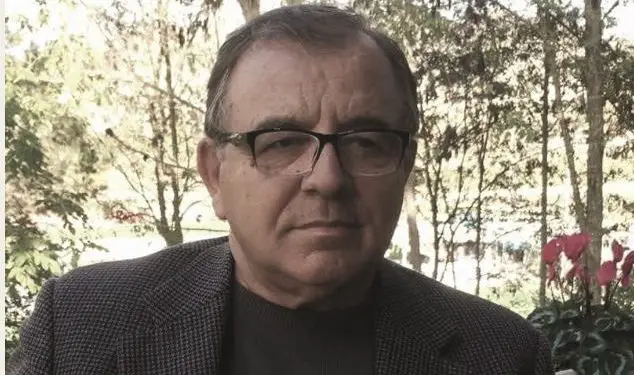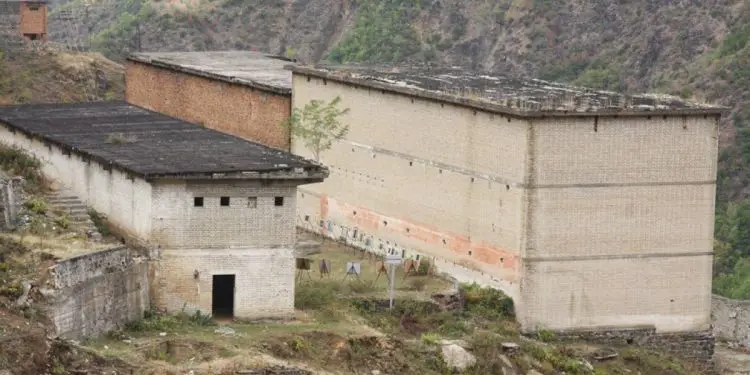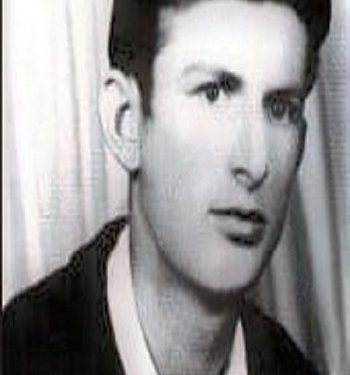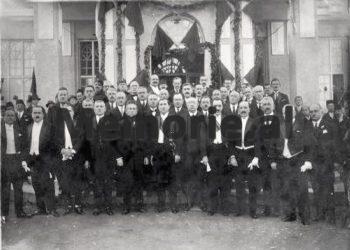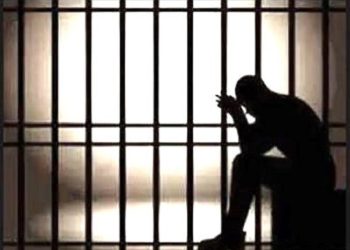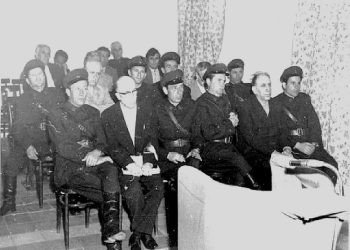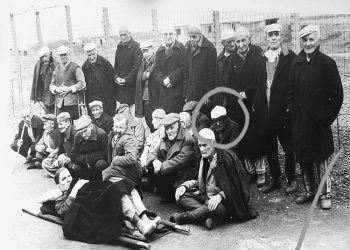By Aleksandr Ndoja
Memorie.al / Revolt are still discussed today. How did the protest start, the raising of the starless flag and the execution of the prisoners?! What was the echo around the world and the fear of communist power?! The current state of the buildings, where ironically three families live in the former cells. But there are also four graves in the middle of the yard, among which is the grave of a relative of the dictator. Gjet Kadeli, ex-convict in the terrible Spaçi prison, tells the whole story of a prison that made history. The declared opponents of the regime of the time had reached record numbers. The gears of the dictatorship had worked at full capacity, in the “production” of the opponents, so much so that in 1964, one of the most terrible prisons of the time, with a capacity of 700 places, would be built. The Spaçi prison, which for 27 consecutive years “educated” through the pit and countless galleries, from which hundreds of thousands of tons of copper ore came out, would mark the record in the choice made by the creators of the prison construction.
Only a few square meters, the base of the prison building and from all four sides, high mountain sides, so much so that with the naked eye, when you look up, the peaks of the mountains seem to meet. And when you turn to the left of the Repsi Bridge, the narrow road that winds through valleys and mountain sides, offers you the feeling of a place where you will meet human pain.
And why are you in a place that, nature created, perhaps only for wild animals, on steep hills, several storied concrete buildings appear, in the parameters of fortifications. Perhaps, the ideators and constructors thought of the eternal dictatorship and equally eternal prisons for political opponents.
Some buildings have turned into ruins, while others, which are standing these years, have no doors or windows. The post-dictatorship hatred for the dictatorship, even there among high mountains, has been in full effect. Although the prisoners would never want to remember that place, a museum, exactly where it should be, as in many former communist countries of the East, would serve history a lot.
And while the buildings offer a view of ruins, everything there turns into imagination. The buildings are together, condemned and free, guilty and innocent, victims and executioners. In fact, all condemned. They all went hundreds of meters underground to extract the ore from there.
Prisoners after employment returned to the silos, while those who were free traveled miles to return to their families. And while those who were free did not dare to oppose politics because they ended up like their fellow sufferers in the gallery, the prisoners had this right because they had nothing to lose. And the prisoners at any one time were over 600 such, with thousands of families, suffering the weight of persecution.
Contemporaries, but also co-sufferers, when they bring to mind particles from the ordeal of torture, talk about the often tense relations between policemen and prisoners. A young man from Fani, after being left tied up in the yard all night, is found dead the next day. But, even though with hundreds of women, children and relatives of the prisoners, for years they were forced to cross the dead end road, often on foot to the prison, the torture for them did not end.
Often, relatives were forced to look at them from a distance, but were unable to meet them. The facts show that Mirdita and the inhabitants of Mirdita have never felt good when they thought that in their territory, there was a “Spaç”, which was identified with terror. The wild mountains, but the mineral in incalculable proportions, were the reason that Mirdita became the bearer of such pain.
Although the retaliation was great, in those few square meters, it would lead to open opposition, until the mass revolt, which time would baptize, with the name: “Revolta e Spaçit”, 1973, but only a decree of the Presidium of The People’s Assembly, signed by Ramiz Alia, in 1991, would make hundreds of prisoners cross the forbidden gate for 26 years, travel on foot, or by car, the long road between the mountains, looking back with the fear that the executioner was still following them…!
Gjet Kadel’s confession: “The Spaç revolt and the raising of the flag without the communist star”!
“At 11:30 p.m…. a few hours after the start of the revolt, Radio-Vatican would broadcast that; in the 26 years of snow in Albania, the first flowers bloomed. In fact, what was that event that seriously shook the communist government in the spring of 1973?
– At 05.30 in the morning, Pal Zefi (from Shijak) escaped from the dungeons, after he was sentenced for 30 days and remained in isolation, and had passed the legal term from 30 days to 31 days. The Camp Security operative was a guard officer and this was the cause of all the consequences of that day.
He escaped from the dungeon and came here to the camp. The guard officer was immediately notified by the internal police. The officer of the guard entered the camp with some policemen. At this time, the first shift of prisoners was preparing to go to work. Pal Zefi also had his imprisoned brother, Gjoka, here.
The officer of the guard came and took Paul by force and sent him back to the dungeon, since he did not agree to go voluntarily. They also used violence against Paul. At this time, the other prisoners intervened and rescued Pal, as he was being raped by the policemen, in their presence. The first to intervene was Pavllo Popa, residing in Vrakë in Shkodër, of Montenegrin origin.
At this moment, other prisoners also intervened and saved Paul from the dungeon. The policemen and operatives came out of the camp beaten, as the prisoners were many and determined. This was the first time that such a case happened, as a result of the accrual against the regime. Afterwards, GJ.Z, a former Operative in this camp, but at this time, was the head of the Mirdita Security, comes to the camp. He goes inside with some policemen and they take Pal Zefi upstairs. The reaction immediately resumed.
At 21.00, a big fire is lit down here. I was lying in bed, as I had a high fever. The fire became so big that it lit up my room. The fire that was lit by the prisoners was the political beginning of the actions in the camp. A 64-year-old prisoner named Jemin Gjoka from Kukësi and Dod Bardhi and 2-3 others were destroying the wooden stands of the socialist emulation and throwing them into the fire.
I get out of bed and for 15 minutes, I warm myself by the fire. Then I leave the fire and go up to the steps of the terrace. Bedri Choku comes and asks me; are you in good health, – I say I’m fine, because you got hotter than necessary. He puts his hand on my shoulder, telling me that; your father in America will also find out about this event.
I tell him that my father in America will also find out, but these are ordinary actions, while we are political prisoners and we must give this revolt a political character. How, Bedriu tells me…??
Yes, we must definitely raise the flag without a star. Where can we get it…?! We do it ourselves; I tell him, go to the library and get us a red meringue. If there is not, we will destroy a red quilt, which my mother had brought me those days. In fact, Bedri Choku brought the red meringue. I tell him to call Mersin Vlashin, to sketch the two proud vultures, since no ink came out to fill it.
Mersini was from Lisi i Mati, convicted twice and spent 36 years in prison. We attached the flag to a spiked stick that we stuck with the heels of our slippers. Then, in the triangle of the third corridor, we placed the flag, but the spear was short. Bedri Çoku immediately called to cheer for the flag. There, cheers were heard from all the prisoners in the square”.
Mr. Kadeli, how did the prison police act?
The police saw that the flag was raised in the camp, while they had arrived there; Kasem Kaçi, General Director of the Police of the Republic and Sulë Manoku, General Director of Prison Camps. They gave orders that; internal guards; to get out of prison. This situation continued throughout the night. Tomorrow; Burrell’s military forces have arrived.
They came with 27 cars, 26 filled with soldiers and one with poisonous chemicals. On the third day, a group of policemen with over 100 people comes singing: “We are boxers and sampistas”. All the prisoners were tied with irons, two by two.
Shahin Skura, prison commissioner, has read the list of “victims” of this revolt. Of these, 80 people were re-sentenced, while 4 (Pal Zefi, Hajri Pashaj, Dervish Bejko, Skënder Daja) were executed by immediate trial. The situation was brought under control by Feçor Shehu himself, at that time, Deputy Minister of the Interior.
Although 3 people were planned to be killed by means of a special trial that took place that night, Hajri Pashaj, a fellow villager of Feçor Shehu, was added to the list of those shot, although he had not been the prototype of the protest.
The reason for being included in the list of those shot was that Hajriu addressed Feçor Shehu harshly, saying that; one day you will answer for this massacre. Although this confrontation ended in favor of power, its foundations; quite a few were shocked. Later; there would be other smaller revolts, but the state would respond with other shootings; keeping the climate of terror alive.
Do you think that many prisoners are buried without an address, without knowing where?
There are still graves not taken by the family members. On the opposite hill there is an unopened grave, next to it, graves opened by family members, to take the remains, to return them to the place from which they left alive, but with handcuffs.
The grave in front of the prison, of the former relative of Enver Hoxha, who suffered in Spaç!
While at Shpali cemetery, outside the cemetery perimeter, there are three other graves. Although for the living, the sentence has ended, 4 dead, whose graves are known, have not yet received the “news” that they are free and still continue to serve their sentence, as if it were 1985!
A former prison guard confidentially explains that; the dead man in front of the prison is a Gyrokastrite and reliable sources say that he was a relative of the dictator Enver Hoxha. But as long as he was alive he never admitted that he was his relative. And if someone asked him what the commander had, he would answer bluntly and harshly: “nothing” – nothing…
While three others found in Shpal, are thought to be from Tropoja. One has been identified by the family, with the surname Goca, and it is expected that his grave will be taken and taken to Tropoja. The source explains that; any dead; a hermetically sealed bottle was placed in the grave, inside which; a letter was inserted where his name and address were written in ink. In all graves opened after 90, such a bottle has been found.
These died naturally from disease, while the 4 shot dead of the revolt; Pal Zefi from Shijaku, Skënder Daja from Fieri, Dervish Bejko from Devolli and Hajri Pashaj from Mallakastra, their execution was done outside the territory of the prison, their graves, nobody knows until today, despite the occasional insistence of the family members .
Spaç prison
Spaçi Prison was a high-security political prison that was active during the communist dictatorship in Albania. The prison is located in the village of Spaç. In 1973, in Spaçi Prison there was a rebellion of prisoners, who managed to raise a non-communist flag.
A similar rebellion was also carried out in Qafe Bari Prison in 1984, where the same drums exploded, and the demand and desire for freedom was raised, which were equally suppressed, with violence and blood.
Some famous intellectuals have suffered political punishments in Spaçi prison. Recently there have been plans that; The Spaçi prison was to be turned into a museum, but to date, no further steps have been taken in this direction.
Spaçi Prison is a monument of cultural heritage in Spaç, district of Mirdita, in the district of Lezha, Albania. This monument is of the “Architecture” type, approved with number: “656/DT 05.12.2007”.
This prison was opened in 1968 and operated until 1988, and according to the data, there were over 1000 prisoners. Built for the use of the Spaçi Mine, where copper and pyrite were extracted. There are about 7 buildings that are part of the prison, but further, there are other buildings that served as camps for prisoners, but also the premises that served as a working environment for people in the area.
It was a mining complex, where not only convicts worked. Currently, it is in a completely destroyed state. It has a typical architecture of the communist period with regular shapes. Memorie.al




